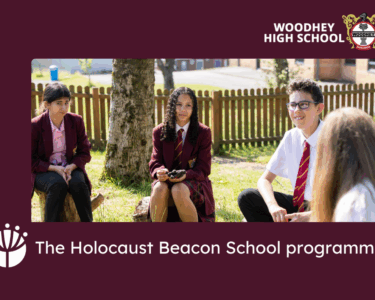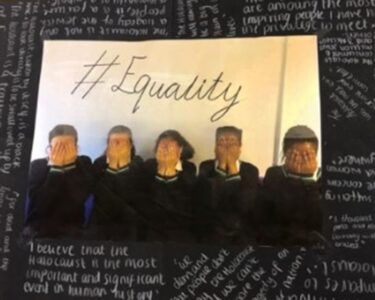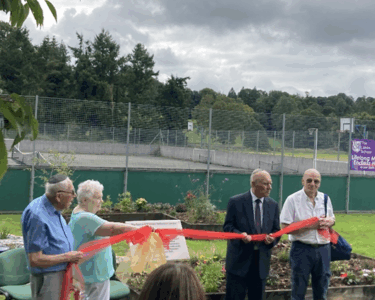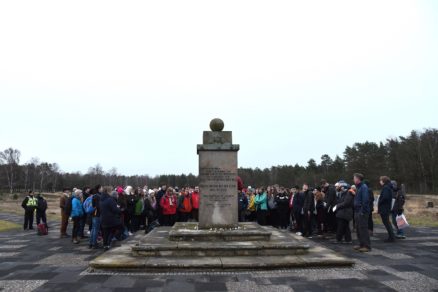 Six months ago, the Centre were delighted to welcome two new colleagues to the teaching team, Helen McCord and Corey Soper. Back then, as Head of External Relations and School partnerships, I took time out to sit with Helen and Corey and have a chat about how they came to join us and learn more about why Holocaust teaching and learning was important to them.
Six months ago, the Centre were delighted to welcome two new colleagues to the teaching team, Helen McCord and Corey Soper. Back then, as Head of External Relations and School partnerships, I took time out to sit with Helen and Corey and have a chat about how they came to join us and learn more about why Holocaust teaching and learning was important to them.
It resulted in a short, introductory, feature piece, where Helen explained,
‘Having worked with PGCE trainees for many years I am keen to assist the centre in working with as many ITE providers as possible to ensure that our colleagues benefit from the Centre’s work right from the start of their careers in teaching’ and where Corey was eager to get stuck into teacher outreach and showed particular commitment to ensuring our resources and teaching were accessible to all learners, supporting teachers in realising what was possible in their classrooms and settings.
Like anyone starting a new job, Helen and Corey were excited, nervous, hopeful and fearful – but little did they know that a new challenge and exciting opportunity was very much ahead of them.
A few short weeks from joining us, the Centre announced a nationally significant, new educational and commemorative project – Belsen 75. This would commemorate the 75th anniversary of the liberation of the former concentration camp Bergen-Belsen by British Forces. The project would be jointly delivered by the Centre and the Holocaust Educational Trust, with support from the National Holocaust Centre and Museum, and made possible thanks to funding from the Department for Education.
We brought all our expertise from years of producing research-led resources for teachers and CPD experience into producing an information pack or ‘resource hub’ of classroom materials. The online resource hub features lessons, assemblies, tutor time activities and legacy project ideas. All these resources made use of authentic primary material from the camp’s history and liberation, exploring the camp through photography, artwork and testimony. To assist teachers with their delivery of this material we produced pedagogical guidance, in order to support our moving students towards a deeper understanding of Belsen without traumatising. The resource hub aimed to enable both teachers and students involved in this project to embed their knowledge and understanding of Belsen in their schools and communities. This would be essential in support of the legacy component of the initiative to ensuring commemoration of the 75th anniversary of liberation would have longevity and meaning. Centre colleagues, particularly Ruth-Anne Lenga, Arthur Chapman, Emma O’Brien, Andy Pearce, Tom Haward and I would be working on resource hub materials, that would also include a historical overview and be online and made available to schools across the country. The team working on this important aspect of the initiative were supported by Helen and Corey – but there was another key component of the project to consider – visits to the former camp.
Whilst our partners the Holocaust Education Trust, would lead on the study visit component of delivering Belsen 75, given their ‘Lessons From Auschwitz’ experience, it would be Helen and Corey who would spear-head the visit aspect on behalf of the Centre. Working with the Trust in this way would enable the project to deliver trips for thousands of A level students to the site of Belsen. These students would then build on their experiences by producing a legacy project, informed by the resource hub materials, their pre and post visit seminars, so that remembrance of and education about Belsen would continue in their schools and communities. Between them, Helen and Corey would be representing the Centre at each of these trips, working with students and teachers from across England to understand, contextualise and memorialise this site.
Belsen 75 is a prestigious and significant project for the Centre to be involved with, and a daunting and ambitious first project for new colleagues to participate in. So, I sat down again with both Helen and Corey to reflect on their involvement thus far. I began by asking whether they had been to Belsen before starting work on this project or joining the Centre. Neither had. Corey explained that his first experience of Belsen was a training visit ahead of the projects launch led by Holocaust Education Trust and Bergen-Belsen Memorial colleagues, in November, so I asked what were his first impressions?
‘…the memorial area of the site, which we visited early in the day, is serenely beautiful: hemmed in on all sides by forest, all that remains is an expanse of heathland dotted with the memorials established by survivors and their families. These are deeply personal stones which stand in contrast to the mass graves which dot the landscape, solemnly declaring “2000 tot”. This part of the site shows the sheer diversity of those who suffered at Belsen, as there are graves remembering victims from across Europe of many faiths, ideologies and backgrounds. We stopped by the stone commemorating Anne and Margot Frank – I personally found it very difficult to imagine the intelligent, passionate diarist who many feel they know as a friend going through the horrors of Bergen-Belsen. Each of those barrows contains huge numbers of people with their own lives and stories as rich and vibrant as the lives of Anne Frank even if we do not have a diary to help us remember them. We reflected for a while on the importance of rehumanising those victims for our students and the importance of this project as a whole. We later toured the site of the prisoner of war camp and concentration camp, both burnt by the British army in 1945. It was incredible to think that tens of thousands of people had at one point lived together what is now this expanse of woodland, and we felt the uncaring weather of the heath keenly even in our winter coats’.
For Helen her reflective remarks about the site were to contrast the visit to her previous experiences, as a teacher, of other Holocaust related sites.
‘In my previous role as a History teacher and a Head of Department I had visited many other former concentration camps with students, Dachau, Sachsenhausen, Thereisenstadt and Auschwitz – Birkenau. Because of those experiences, I felt that I knew what to expect at the site, yet of course Bergen – Belsen is a very different site in so many ways. To an extent of course all of these former sites of genocide are unique, yet Dachau and Sachsenhausen in particular have similarities, both being former ‘model’ SS camps, close to the major cities of Berlin and Munich, retaining some features of the camp that are instantly recognisable. The imposing gatehouses with the well-known “Arbeit Macht Frei” across the entrances, the barbed wire, watch towers and the remaining barracks. In a sense, this makes a visit to these sites with students an easier one. In no way am I implying that visits to these sites are less traumatic, but with evidence that is more physical students can more readily visualise what the camp may have looked like. Bergen–Belsen retains none of the physical features that students most associate with former sites of Nazi concentration camps. Deliberately, yet controversially the liberating British troops took the decision at the time to destroy buildings and barracks in the former camp due to their contamination and fears about the spread of the deadly disease, typhus.’
This was an interesting juncture in the conversation, the interplay between the educational pack and the trips – what is visible, what is hidden – what the challenges and opportunities might be for site-based learning. So, I asked what is it you learn and experience at the site that is different from an educational pack, textbook or classroom-based lesson?
For Helen, discovering a sense of place and space was key. She explained:
‘Despite the potential challenges that this site poses for us as educators, the lack of physical evidence has not proven to be a barrier to student knowledge and understanding at all. The site itself has been carefully marked with information plaques, images where we have them and maps of the site to enable students to visualise the space, as it would have been. The tree line and empty spaces mark the former perimeter fence, giving the visitor a sense of the vast scale of the camp as it had expanded by 1945. HET educators working alongside Belsen educators, Corey or myself, use their knowledge of the site alongside images and testimony to further develop and secure student understanding throughout the visit.
What I was entirely unprepared for was the peacefulness of the site. Belsen is one of the most peaceful places that I have ever visited; I had not expected this at all. Bergen – Belsen is located on heath land and is today a huge expanse of space but the peacefulness is more than that. I realised that the difference between this site and other former concentration camps is that whilst it retains a sense of the horror and the trauma that took place there, it is something else today. It is a burial site. Mass graves punctuate the landscape and smaller individual markers appear, gravestones not marking individual burial plots, but representing a family member’s desire to remember and name their loved one known to have perished there. In this sense, the site of Belsen today is also a hopeful place; a place to remember and to commemorate all of the victims of the Nazis who remain buried there. The mass graves stand as evidence of Nazi atrocities and the horrors of the Holocaust, and despite the anonymity of those buried there, their physical presence set in this beautiful landscape, ensures that they will not be forgotten. ‘
Corey was quick to echo some of this sentiment and, based on his first visit, plus two project visits with students and teachers from various regions…
‘… at Belsen, it is much easier to gain a sense of the scale of the camp. Whilst Belsen was smaller than camp-complexes like Auschwitz-Birkenau, it still extends for some miles of forest and field, which helps students visualise the terrible scale of the atrocities committed there. What struck the students particularly on my first visit was that no building work, construction or excavation had happened in such a wide area, as the whole site is considered to be one large cemetery.
It has been great for students to see the Displaced Persons camp and see the places they had seen in photographs in the pre-visit seminar, such as so-called ’Freedom Square’ where victims began to rebuild their lives, marry and form their own organisations. Here I shared one of the most moving stories from my research on Belsen – the arrival of the lipstick. During the aftermath of liberation, Mervin W. Gonin recorded how the British Red Cross arrived with lipstick which was distributed to the survivors: “I don’t know who asked for lipstick. I wish so much that I could discover who did it, it was the action of genius, sheer unadulterated brilliance. I believe nothing did more for these internees than the lipstick. Women lay in bed with no sheets and no nightie but with scarlet red lips, you saw them wandering around about with nothing but a blanket over their shoulders, but with scarlet red lips. I saw a woman dead on the post mortem table and clutched in her hand was a piece of lipstick. At last someone had done something to make them individuals again, they were someone, no longer merely the number tatooed on their arm. At last they could taken an interest in their appearance. That lipstick started to give them back their humanity.”
One major challenge for visitors to the Belsen site is that the original site was burnt down by the British army to contain the spread of typhus, which means many of the original buildings have been destroyed. Luckily the excellent educators employed by the Belsen Memorial are excellent at showing the different areas of the site and they have intimate knowledge of the former camp and could lead students through the different areas.
A final challenge of the trip which I would stress to all future participants is that the Luneberg heath can be terribly cold and open to the elements. Our group were briefly hailed on, which the teenage participants handled with impressive stoicism, but future participants should definitely remember hats, scarves, gloves and layers.’
It is early days in the delivery of the Belsen 75 project and pre-visit seminars, trips, post visit reflections and legacy projects are only just underway, but I asked Corey what has impressed him most?
‘I have to say it’s the student and teacher engagement – my first group was exceptional. Firstly, I had full attendance despite all the disruption from Storm Ciara! Secondly, many had extensive subject knowledge and experience of learning about the Holocaust and worked with those without to help them contextualise and understand the site. They immediately understood the importance of the programme and worked to produce presentations in our pre-visit seminar on each period in the camp’s life, focussing on the experiences of the victims and survivors. Many were struck by the capabilities of victims to forge new lives for themselves in the Displaced Persons camp. I am really looking forward to our post-visit seminar to see where this group of young people will take their legacy projects in their schools and communities. Our teachers were also excellent and showed a real spread of subject specialisms, from History to RE to Maths! Each really contributed to the CPD discussions built into the day where they worked with the IHRA guidelines to reflect on their own pedagogy and at Belsen itself the respect and engagement has been superb.’
Helen agreed and added:
‘The groups of teachers and students that I have worked with have all been really engaged and thoughtful. They have asked many insightful questions and have immersed themselves with every aspect of the project so far. I am really looking forward to seeing the impact that this has upon their Legacy projects and the work that they do in their schools and communities to commemorate the anniversary of liberation.’
Corey and Helen had so much to say about their visits. Clearly their experiences at the site have reaffirmed the importance of #Belsen75 project and their commitment and desire to ensure as many young people, teachers and schools would benefit from the visit opportunity and the resource hub materials being prepared. You can find out more on the project website.
The conversation ended with reflections on Belsen 75’s significance. Corey was clear,
‘This anniversary is an essential moment in both British history and the history of the Holocaust. In a time where Holocaust denial, nationalism and antisemitism are on the rise across Europe it is essential that we keep the memory of these events alive. It’s also the first time we see three organisations in the field – The Centre, The Holocaust Educational Trust and the National Holocaust Centre and Museum – working together to deliver such an excellent program, bringing together huge amounts of expertise and experience in Holocaust teaching and learning. I’ve felt privileged to work alongside our partners in Holocaust Educational Trust on the visit’s component especially, but if schools or colleagues are unable to join the trips, they can still commemorate the anniversary using the projects resource hub materials. We have a range of whole school resources which focus on the experience of survivors and how many coped using art and other creative outlets. We have a small four-lesson scheme of learning that can be used in schools which will give your students a context for the anniversary of the liberation.’
For Helen, the duty to survivors, and the inevitable time-sensitive nature of such anniversaries, was paramount.
‘I feel very privileged to have been a part of all of the stages of this important commemoration project. This may be the last significant anniversary upon which we can draw upon the tireless and invaluable contributions made by survivors in their determination to make sure that we all know and remember what happened to them both during the Holocaust and at Bergen-Belsen specifically. Their involvement, contributions and support for this project mean that we can help in some way to ensure that their experiences are remembered and that those who did not survive are not forgotten.’
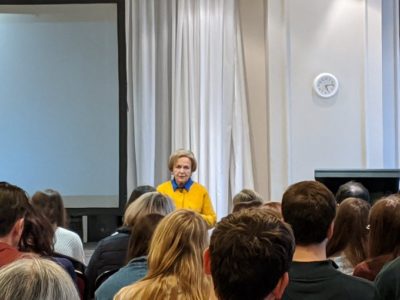 All that was left to be said at the end of our chat was ‘Good Luck Corey and Helen – as they undertake the remaining visits, support Holocaust Educational Trust colleagues and their educators from across the country and work to ensure schools and teachers are engaging in this educational and commemorative project.’ The visits component of the project will end prior to the April 15th anniversary – but whilst that chapter closes, Helen and Corey will continue to support and engage, alongside Holocaust Education Trust and National Holocaust Centre and Museum colleagues, to support legacy projects. At the Centre, we are all looking forward to seeing what schools and communities devise as a result of this important initiative – their engagement with and response to resource hub materials and the site visits.
All that was left to be said at the end of our chat was ‘Good Luck Corey and Helen – as they undertake the remaining visits, support Holocaust Educational Trust colleagues and their educators from across the country and work to ensure schools and teachers are engaging in this educational and commemorative project.’ The visits component of the project will end prior to the April 15th anniversary – but whilst that chapter closes, Helen and Corey will continue to support and engage, alongside Holocaust Education Trust and National Holocaust Centre and Museum colleagues, to support legacy projects. At the Centre, we are all looking forward to seeing what schools and communities devise as a result of this important initiative – their engagement with and response to resource hub materials and the site visits.
At the Centre we are hugely proud to working on this initiative – as Programme Director, Ruth-Anne Lenga stated at the November launch:
“75 years on, the need to combat antisemitism and heal divisions in society remains urgent. As survivors of the Holocaust become increasingly few with the passing of time, this anniversary is pivotal in remembering this disturbing past and collectively reflecting on its legacy.”
Helen, Corey and the Centre’s entire team have been passionate about this work from the outset and are curious and excited by the prospect of innovative, respectful, engaging outcomes from schools and communities marking this anniversary taking place across the country in coming weeks. Working with the survivors, liberators and alongside partner organisations on this project continues to be a privilege, a challenge and an opportunity to contribute to, and be part of, a significant moment in national consciousness.
Belsen 75 continues to be a team effort, within the Centre and alongside our Holocaust Educational Trust and National Holocaust Centre and Museum partners – but what a way for Helen and Corey to begin a new job and join the UCL Centre’s team than be given the opportunity to work on such an important and innovative project! One can only wonder what lies ahead…
Nicola Wetherall MBE

